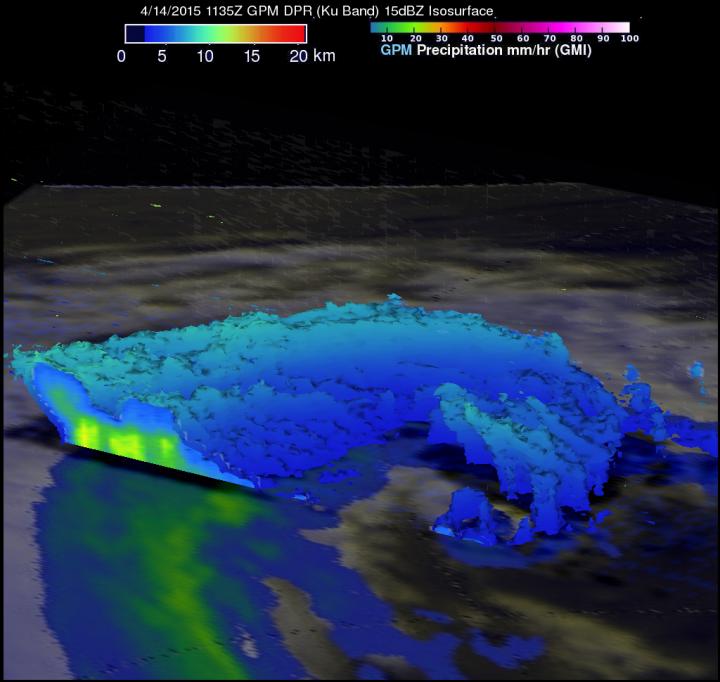GPM sees wind shear affecting remnants of Extra-tropical Cyclone Joalane

GPM data from April 14 showed that Joalane's highest storm tops were as high as 9.37 km (5.8 miles) in rain bands south of Joalane's center of circulation. Image Credit: SSAI/NASA, Hal Pierce
The Global Precipitation Measurement (GPM) core observatory satellite had a last look at the remnants of Tropical Cyclone Joalane on April 14, 2015 at 1135 UTC (4:35 p.m. local time/7:35 a.m. EDT/U.S.).
GPM's Microwave Imager (GMI) instrument found very little rainfall around Joalane's center and light to moderate rainfall in bands on the outer edges of the rapidly weakening tropical cyclone.
At NASA's Goddard Space Flight Center in Greenbelt, Maryland, reflectivity data derived from the Ku band on GPM's dual frequency radar was used to create a three-dimensional image of the extra-tropical cyclone.
The 3-D image showed cloud tops were tilted toward the south, clearly indicating how strongly vertical shear was affecting the rapidly weakening tropical cyclone. GPM data showed that Joalane's highest storm tops were as high as 9.37 km (5.8 miles) in rain bands south of Joalane's center of circulation.
Joalane continued to weaken and is expected to dissipate in a day or two.
Media Contact
All latest news from the category: Earth Sciences
Earth Sciences (also referred to as Geosciences), which deals with basic issues surrounding our planet, plays a vital role in the area of energy and raw materials supply.
Earth Sciences comprises subjects such as geology, geography, geological informatics, paleontology, mineralogy, petrography, crystallography, geophysics, geodesy, glaciology, cartography, photogrammetry, meteorology and seismology, early-warning systems, earthquake research and polar research.
Newest articles

Superradiant atoms could push the boundaries of how precisely time can be measured
Superradiant atoms can help us measure time more precisely than ever. In a new study, researchers from the University of Copenhagen present a new method for measuring the time interval,…

Ion thermoelectric conversion devices for near room temperature
The electrode sheet of the thermoelectric device consists of ionic hydrogel, which is sandwiched between the electrodes to form, and the Prussian blue on the electrode undergoes a redox reaction…

Zap Energy achieves 37-million-degree temperatures in a compact device
New publication reports record electron temperatures for a small-scale, sheared-flow-stabilized Z-pinch fusion device. In the nine decades since humans first produced fusion reactions, only a few fusion technologies have demonstrated…





















